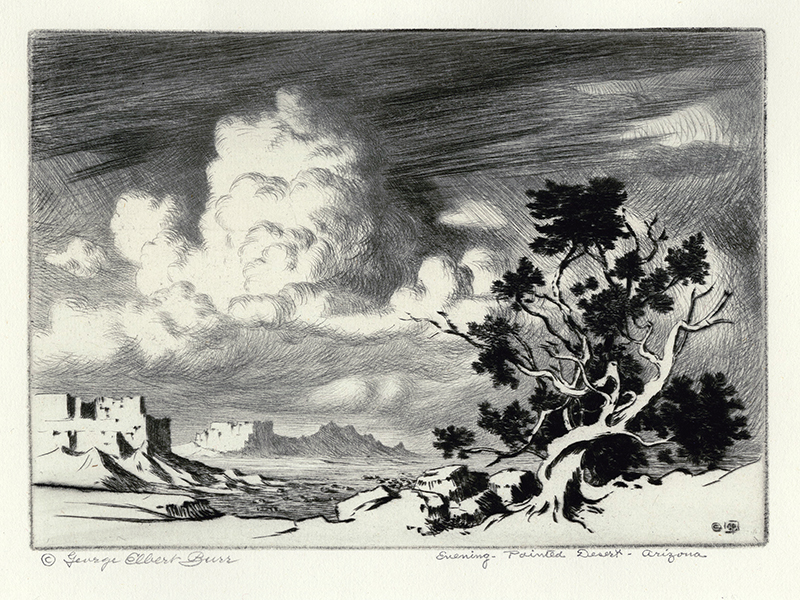Evening Painted Desert – Arizona is a drypoint from about 1928 by American artist, George Elbert Burr (1859-1939). It is pencil signed and dated and the artist's monogram is incised into the plate in the lower right image. It was printed by the artist on ivory FJ Head & Co. watermarked laid paper and the platemark measures 4-7/8 x 6-15/16 inches. The references are Seeber 269 and American Etchers 269. The edition size is unstated.
In Evening Painted Desert – Arizona, Burr captured thunderclouds racing across the landscape promising moisture to the parched land. A twisted, lone juniper epitomizes the struggle of life within this arid landscape. Located in Northern Arizona, the Painted Desert is a broad region of rocky badlands encompassing more than 93,500 acres. Home to some of the nation’s most memorable formations and features, volcanic eruptions, earthquakes, floods, and sunlight, all combined to create the Painted Desert. Deposits of clay and sandstone, stacked in elegant layers, reflects the setting Arizona sun in colorful radiance.
George Elbert Burr, painter, printmaker, and illustrator, was born in Munroe Falls, Ohio on 14 April 1859 to Linus E. and Lucy Ellen Gaylord Burr, and was raised in Cameron, Missouri. His earliest instruction in drawing and painting was provided by his mother and he made his first attempts at etching in the early 1870s. In December 1878, Burr enrolled in the Chicago Academy of Design (now the School of the Art Institute of Chicago) but he terminated his studies in April of the following year. In 1888 he was creating illustrations for Schribner’s and Harper’s magazines as well as for John Muir’s Picturesque California, and, after moving to New York, he illustrated for Cosmopolitan and Leslie’s.
In 1906, Burr and his wife moved to Denver. A few of his color etchings were included in the 1915 Panama Pacific International Exposition and the following year he was represented by two etchings in the First Annual Exhibition of the Brooklyn Society of Etchers at the Brooklyn Museum. In 1921 he copyrighted the last of the thirty-five etchings in the Desert Set, which was circulated in exhibitions by the American Federation of Arts. For health reasons, Burr had to leave the winter chill of Denver and purchased a home in Phoenix, Arizona in 1927.
Burr was in the unique position of self-promoting his work and in January 1930 wrote to R. P. Tolman, assistant curator at the Smithsonian Institution: "It's lots of fun to be a 'poor artist.' Nearly fifty years I've been, except for health limitations, supremely happy in my work, and am constantly surprised in the number of people that also seem to get pleasure out of my labor. It seems so odd, that without effort, I've always sold more than Mrs. Burr and I have needed for all our fourteen years of travel and other so-called luxuries."
Burr was a member of the American Institute of Graphic Arts; Arizona Society of Artists; Brooklyn Society of Etchers; Cactus Club, Denver; California Society of Etchers; Denver Art Association; National Arts Club of New York; New York Society of Etchers; Phoenix Fine Art Association; Print Makers’ Society of California; and Société aux Etats-Unis. He served as the first president of the Denver Art Association and president of the Phoenix Art Association. During his lifetime Burr's work was exhibited at the Bibliothèque Nationale, Paris; the British Museum, and the Victoria & Albert Museum, London; the National Museum and the Smithsonian Institution, Washington D.C.; and the Brooklyn Museum.
George Elbert Burr died in Phoenix, Arizona on 17 November 1939.



